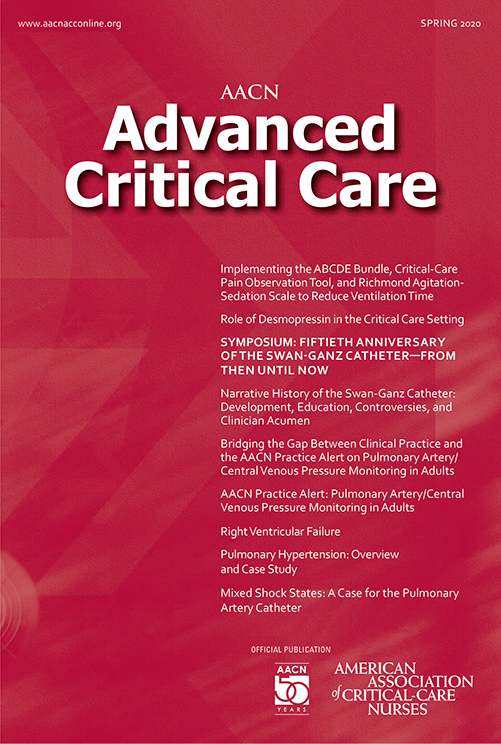Concerned about the potential negative outcomes, CHRISTUS Good Shepherd Medical Center in Longview, Texas, developed an integrated approach that reduced ventilation time for patients in its 34-bed intensive care unit.
“Implementing the ABCDE Bundle, Critical-Care Pain Observation Tool, and Richmond Agitation-Sedation Scale to Reduce Ventilation Time” is the first study to examine the effects of implementing protocol-directed sedation with the coordinated use of two evidence-based assessments across multiple disciplines. Findings from the 2018 intervention offer guidance for healthcare professionals caring for patients with the most serious COVID-19 symptoms. The study is published in the spring issue of AACN Advanced Critical Care.
The awakening and breathing coordination, delirium monitoring/management and early mobility (ABCDE) bundle is a protocol used by respiratory therapists and nurses to assess patients receiving mechanical ventilation. The bundle includes the Critical-Care Pain Observation Tool (CPOT) to assess a patient’s pain levels and the Richmond Agitation-Sedation Scale (RASS), which measures the quality and depth of sedation.
The use of CPOT and RASS together gave critical care nurses a guideline to use when patients exhibited pain or agitation while receiving ventilation. Using both tools allowed the staff to either treat pain or adjust sedation as appropriate.
After ABCDE bundle implementation, mean ventilation time significantly decreased by nearly 50%, a decrease of nearly two days. The decrease in ventilation time was observed among all patients. Sedation time was also reduced, but this finding was not statistically significant.
Despite a nursing staff compliance rate of 76.5%, the data reveals that twice as many patients had a positive outcome after the protocol was implemented.
Co-author Jennifer Bardwell, DNP, FNP-C, AGACNP-BC, is a nurse practitioner at CHRISTUS Good Shepherd Medical Center and Taylor Medical Center Urgent Care in Longview, Texas.
“Performing the CPOT assessment after finding high scores on the RASS assessment often helped nurses identify signs of pain rather than agitation, which would have required increasing the sedative dose,” she said. “The components of the ABCDE bundle provided critical care providers with steps to discontinue sedation and mechanical ventilation for patients as early as possible.”
Of the 34 patients included in the post-intervention phase of the study, one patient required reintubation within 24 hours. None of the remaining 33 patients was readmitted within 30 days of hospital discharge or reintubated within 30 days of extubation.
AACN Advanced Critical Care is a quarterly, peer-reviewed publication with in-depth articles intended for experienced critical care and acute care clinicians at the bedside, advanced practice nurses, and clinical and academic educators. Each issue includes a topic-based symposium, feature articles and columns of interest to critical and progressive care clinicians. The American Association of Critical-Care Nurses (AACN) publishes the journal.
Access the issue by visiting the AACN Advanced Critical Care website at http://acc.aacnjournals.org/.
About AACN Advanced Critical Care: AACN Advanced Critical Care is a quarterly, peer-reviewed publication with in-depth articles intended for experienced critical care and acute care clinicians at the bedside, advanced practice nurses, and clinical and academic educators. An official publication of the American Association of Critical-Care Nurses, the journal has a circulation of 4,845 and can be accessed at http://acc.aacnjournals.org/.
About the American Association of Critical-Care Nurses: For more than 50 years, the American Association of Critical-Care Nurses (AACN) has been dedicated to acute and critical care nursing excellence. The organization’s vision is to create a healthcare system driven by the needs of patients and their families in which acute and critical care nurses make their optimal contribution. AACN is the world’s largest specialty nursing organization, with more than 120,000 members and over 200 chapters in the United States.
American Association of Critical-Care Nurses, 27071 Aliso Creek Road, Aliso Viejo, CA 92656;
949-362-2000; www.aacn.org; facebook.com/aacnface; twitter.com/aacnme
Original post https://alertarticles.info


